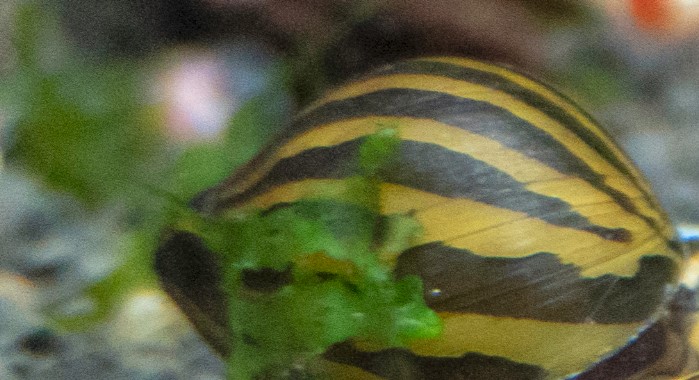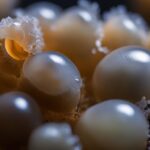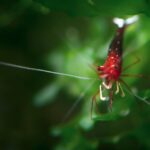Table of Contents
When it comes to having a successful shrimp tank, Nerite snails should be an essential part of the setup. Not only are these animals aesthetically pleasing, but they also provide a number of benefits for shrimp tanks. Nerite Snails help maintain biological balance in an aquarium by eating excess algae and leftovers from fish or other invertebrates as well as cleaning debris off tanks walls. They can act like janitors, clearing up messes we might not be able to get to. Read on to learn more about Nerite Snails with Shrimp living together.
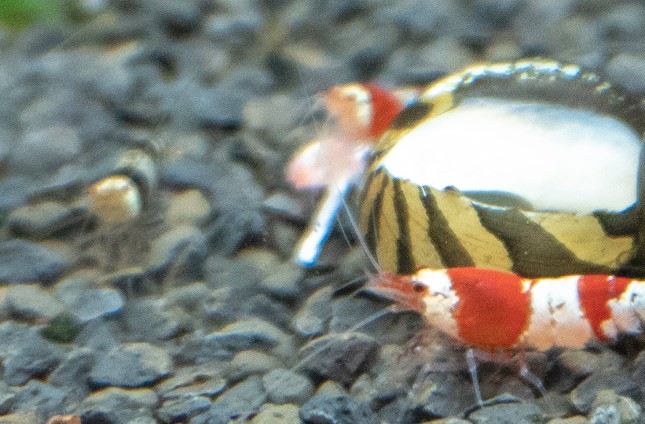
How many Nerite Snails should you pair with Shrimp
When deciding how many Nerite Snails to buy, it is important to consider the size of your tank. Generally, you will want one snail per 5-10 gallons (20-40 liters), however this could vary depending on the conditions of your tank and the amount of algae present. If your algae problem is particularly bad to the point that you can’t see through the other side of the tank, aquarists may advise that 1 snail per 1-3 gallons (~ 10 liters) is necessary. Although such a high number may seem extreme, it will be worth it in time as Nerite snails are capable of dealing with even large amounts of algae growth long-term.
Ultimately, don’t rush into buying too many Nerite Snails with shrimp at once–add more as needed over time! Even if you have an out of control situation right now, given enough time and patience those numbers can quickly turn around. Too many Nerite Snails in your aquarium will soon make it difficult for you to feed them all. Take your time and let them do their job – by introducing them gradually over a period of months or even years, you’ll be able to keep an effectively healthy tank with happy inhabitants!
Also, as you add them, monitor the interaction with your Shrimp, the last thing you want is an upset Shrimp colony.
Speciality Nerite Snails for Shrimp Tanks
If you are looking to light up your tank a little, there are some amazing Nerite snails available, here are three of my favourite.
Horned Nerite Snail
Horned nerite snails are popular additions to freshwater tanks of shrimp and other invertebrates. Despite their name, these snails are not part of the Neritina genus but actually classified as Clithon species. Clithon corona and Clithon diadema are the two most common horned nerite snails that share a similar coloration and shell shape. They make great tankmates as they do not reproduce in freshwater, only growing to be around 1 inch in size. Plus, they are excellent algae-eaters and can help keep your tank clean.
These small snails also have another unique feature – they are polymorphic, meaning no two individuals look exactly the same. The most distinguishing feature is the spire on top of the shell, which can look like horns or spikes depending on each individual snail’s genetics. Horned nerite snails may be tiny but they make sweet pets with their colorful variations and peaceful presence in an aquarium!
Zebra Nerite Snail (my Favourite)
The Zebra Nerite Snail is known for its unique black and gold striped shell. They are small in size and are known to be peaceful and low-maintenance creatures, making them a great addition to any shrimp aquarium. These snails are also known for their ability to clean algae off of aquarium walls and plants, helping to improve the overall health and cleanliness of the tank. However, it’s important to note that they are sensitive to high levels of copper and medications commonly used in aquariums. As with any underwater creature, proper research and care should be taken to ensure the health and well-being of the Zebra Nerite Snail.
Red Racer Nerite Snail
The Red Racer Nerite Snail is a very popular and desirable addition to freshwater shrimp tanks. It’s scientifically known as Vittina waigiensis, but can be referred to as a nerite. These aquatic snails are relatively small but have beautiful shell patterns that add to the decor of any aquarium.
These Red Racer Nerites have an appetite for algae, helping keep the water clean, and are unable to breed in freshwater so aquarium owners don’t have to worry about overpopulation issues. They thrive best in aquariums with 7 (sometimes even a little smaller will work) gallons or more of water. With their striking colors, algae-eating habits, and population control capabilities, this species of snail makes for an ideal addition when thinking about which animals could bring life our shrimp tank!
Midnight Black Nerite Snail
I highly recommend buying a Midnight Black Nerite Snail for your aquarium. They have a dark shell that blends perfectly with dark substrates. The shells can be black or dark brown, with occasional specks of gold, grey, or orange. I think they look amazing with lots of greenery in your tank and I have them as my second favourite snail.
What do Nerite Snails eat when in a Shrimp Tank
Nerite snails are excellent algae eaters, and they provide a great service to aquariums. They prefer soft algae such as green dust algae, green spot algae and other forms of growth. It’s important for them to get proper nutrition; otherwise, they can starve.
These snails move slowly but thoroughly around the tank consuming all traces of unwanted plant life. They can even clean decorations and plant leaves from any remaining growth that lingers on them. They’re incredibly efficient in their work and leave nothing behind for other tank inhabitants to survive off of. If there’s not enough algae present in the aquarium, their diet can be supplemented with commercial options such as algae wafers, other options include spinach, alfalfa sprouts. This is a great way to ensure your nerite snail stays healthy and happy by providing it with all its nutritional needs.
How long do Nerite Snails live in Shrimp Tanks for.
It is estimated that Nerite snails can live up to 1-3 years with proper upkeep. However, some aquarists claim their Nerite snails lived up to 5 years. Of course, there is no concrete answer when it comes to estimating the lifespan of a Nerite snail as it really depends on the conditions they’re kept in, how well they’re fed and the size of them when you first get them.
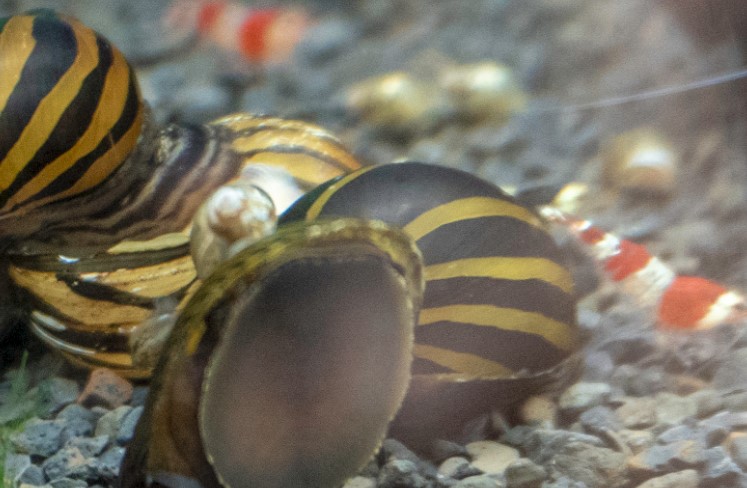
I have not read or seen anything that indicates the life of a Nerite snail changes when in the same tank as Shrimp. But by providing your Nerite snail with a healthy environment and diet – made up of brackish vegetables such as spinach or alfalfa sprouts along with flaked fish food – you can greatly extend the lifespan of your pet. Once settled into their environment, these savvy evolutionary critters are relatively adaptable in terms of water hardness, temperature range, and salinity levels as long as you maintain optimal living conditions according to their needs – always keeping an eye on ammonia levels
Snails poop for Shrimp
Perhaps the most interesting part of this is that infusoria-producing snails are said to be beneficial for shrimp tanks – as the tiny organisms provide food for the active little creatures. Infusoria are single celled typical animals that eat and capture plankton, then get eaten directly by fish including shrimps. Therefore owning some type of infusoria snail can prove quite beneficial as tank mates! As a matter of fact this type of snack coverts into nutritious fuel rather quickly in order to maintain an active habitat full of thrifty critters.
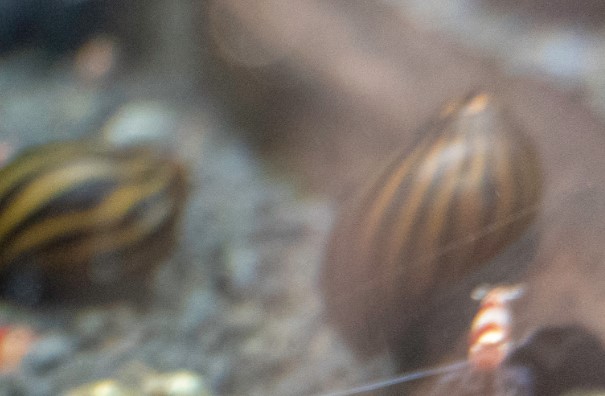
In Conclusion
Nerite snails are a great addition to shrimp tanks. They help keep the tank clean by consuming algae and other plant life, provide food for shrimp, and don’t overpopulate due to their inability to breed in freshwater. These snails require very little maintenance as long as they are given plenty of food and a healthy environment to live in. With proper care, these beautiful snails can live up to 1-3 years, and with the right diet and living conditions, they can even live up to 5 years.
If you are considering a wider selection of snails, check out my in depth article covering other snail selections worth considering in your shrimp tank.

